14.02.03 Lk. 22:7-13; (See also Mt. 26:17-19; Mk. 14:12-16) Upper Room
DISCIPLES MAKE PREPARATIONS FOR PASSOVER
7 Then the Day of Unleavened Bread came when the Passover lamb had to be sacrificed.
8 Jesus sent Peter and John, saying, “Go and prepare the Passover meal for us, so we can eat it.”
9 “Where do You want us to prepare it?” they asked Him.
10 “Listen,” He said to them, “when you’ve entered the city, a man carrying a water jug will meet you. Follow him into the house he enters. 11 Tell the owner of the house, ‘The Teacher asks you, “Where is the guest room where I can eat the Passover with My disciples?”’ 12 Then he will show you a large, furnished room upstairs. Make the preparations there.”
13 So they went and found it just as He had told them, and they prepared the Passover.
“Go and prepare the Passover meal.” In the first century, as today, the “men making preparations” is more of a formal ritual than actual cleaning. Truth be told, it was the responsibility of the woman of the house to prepare for the Passover meal, but since the husband/father is the spiritual head of the family, he made a ritual cleaning. Therefore, when Jesus told his disciples to prepare the meal, they were not going to clean house or become master chefs, they performed the ritual obligation that every family man had to perform.[1] The location of the upper room is seldom questioned even though scholars claim two possible locations:
- The Syrian Orthodox Church of St. Mark (minority view), and
- Mount Zion. This site is almost universally agreed upon (see 14.02.01.Q1 below)
The word “preparations” meant extensive house cleaning to remove any yeast, which is in this case, symbolic of sin in the typical Jewish home. In essence, the meal was eaten in a state of Levitical purity (Jn. 13:10; Num. 19:19). Anything related to any kind of grain had to be removed and an example of this regulation is found in the Mishnah.
These must be removed at Passover: Babylonian porridge, Median beer, Edomite vinegar, and Egyptian barley-beer; also dyer’s pulp, cooks’ starch-flour, and writers’ paste. Rabbi Eliezer says: Also women’s cosmetics.
Mishnah, Pesahim 3.1
What Jesus meant for them to do when He said “Go and prepare the Passover meal” is unknown, because some things may have been done by the host. An abbreviated list is as follows:
- Select and care for the sacrificial lamb. Most certainly the disciples did not follow Jesus all over town with a little lamb. The host probably cared for it on their behalf.
- They inspected and cleaned the house of every crumb of leavened bread (Mt. 13:33, 16:6, 11-12)
- They purchased the wine,[2] herbs, spices, bread, and other foods.
- They had to furnish the triclinium table and the rest of the room
- After the ritual slaughter at the temple, they had to roast it at the home where they were going to observe the Passover Feast/Last Supper.
The number of days Passover was celebrated has not changed over the centuries. It has always been combined with the Feast of Unleavened Bread and the Feast of First Fruits, creating an eight-day celebration. In the course of time, all three festivals became known simply as the festival of “Passover.”[3]
Josephus presented two slightly different versions of the festival. The festival according to Moses was for seven days when they were to eat bread made without yeast. On the first of those eight days, the yeast was to be removed from their homes. No work was to be done during this celebration, with the exception[4] of food preparation. The Feast of Unleavened Bread was celebrated on the day God brought the Israelites out of Egypt (Gen. 12:15-17). According to Josephus, somewhere in the course of history the Day of Preparation was considered as sacred as the other days of the festival, thereby creating an eight day celebration. Other times it was not. Hence, he recorded two slightly varying accounts concerning the length.
In memory of the want we were in, we keep a feast for eight days, which is called the Feast of Unleavened Bread.
Josephus, Antiquities 2.15.1 (317)
The Feast of Unleavened Bread succeeds that of the Passover, and falls on the fifteenth day of the month, and continues seven days, wherein they feed on unleavened bread.
Josephus, Antiquities 3.10.5 (249)
At the end of the Feast of Unleavened Bread was the Passover Feast which culminated in the sacrificial offering of the lamb (Lk. 22:7). To Christians this feast became known as the Last Supper. Jesus never intended this sacred meal to be a celebration of a historic event, even though that is how every Jew recognized it. Rather, it pointed to the future and would only be recognized after His death and resurrection. The elements of the meal pointed to the cross and the cup of wine pointed toward the future messianic wedding banquet. In the interim Jesus discussed the unity of the church.[5]
“A man carrying a water jug.” It was, and still is, common in this part of the world for women to carry water. It was one of the accepted domestic tasks of women – to carry water from the village well to their homes. An example is found in John 4, the story of the Samaritan woman whom Jesus met at the well. For a man to carry a jar of water was highly unlikely, except in Jerusalem for these three situations:
- In the temple, so much water was used for various sacrificial rituals, as well as washing the temple floors, altars, etc., that men were assigned to carry the heavy jars.[6]
- Josephus said that water sellers sold water in pitchers or “standard measures” during times of drought.[7]
- Such men were employed by wealthy home owners. While homes had cisterns where rain water stored, that water became stagnant or stale throughout the long, hot, dry summer months. Homeowners then either carried fresh water from one of the Jerusalem pools or purchased it from a water seller.
Even after the temple was destroyed and the city was rebuilt, some men continued to function as professional water carriers serving private homes.[8] Therefore, for Jesus to tell His disciples to look for a man carrying water, this was not as much of an oddity as modern students think it would have been.
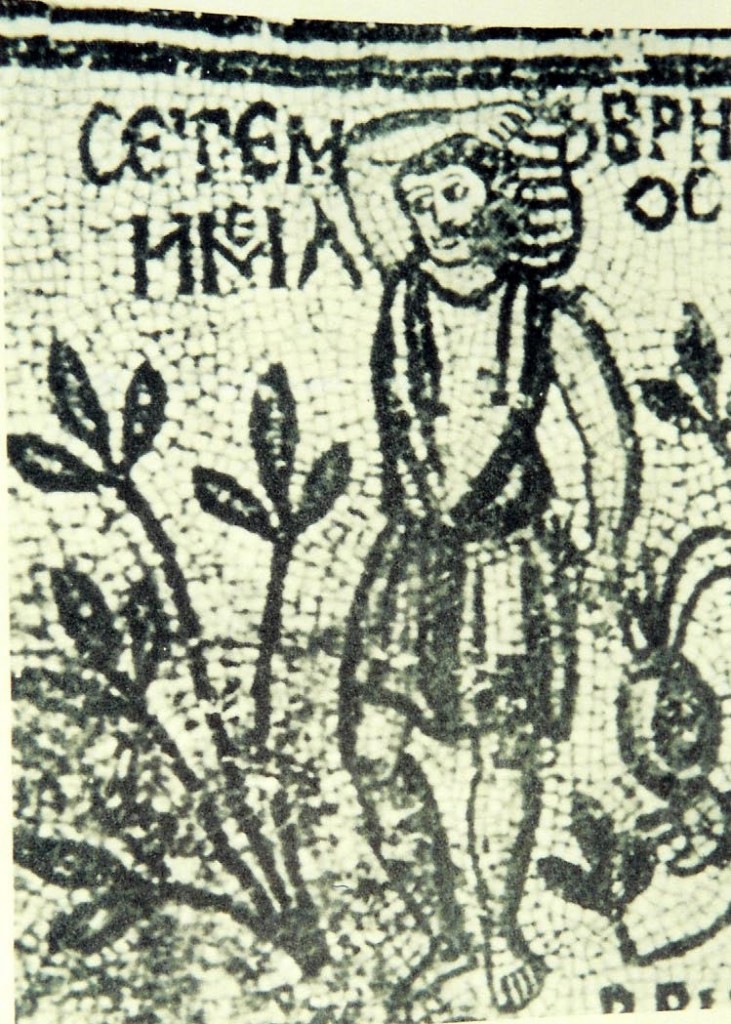
14.02.03.A. A SIXTH CENTURY (B.C.) MOSAIC OF A MALE WATER CARRIER. This Byzantine mosaic was found in Beth-Shean. The custom of carrying water was generally the task of women, with the exception of a few men who were employed as professional water carriers. Those of wealth could afford to have water carriers deliver fresh water from an aqueduct to their home all year long.
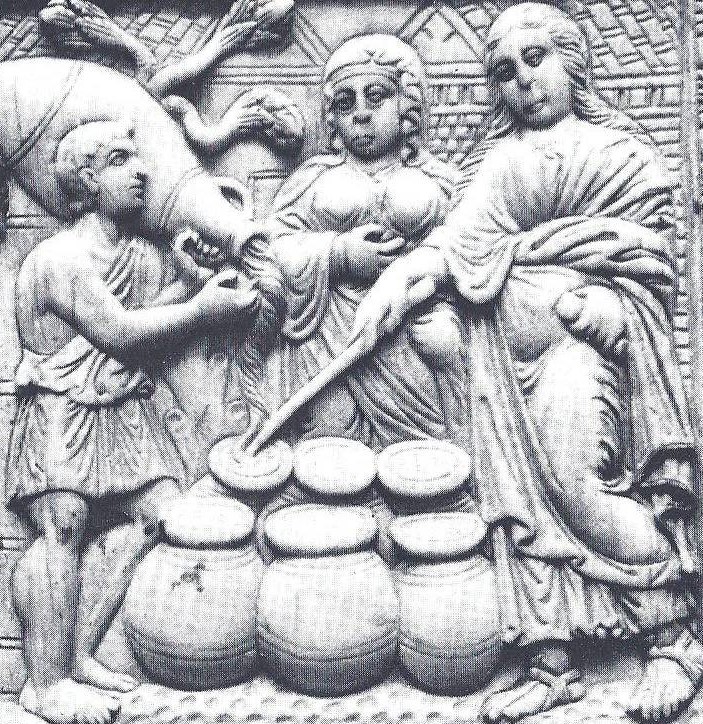
14.02.03.B. A RELIEF OF A MALE WATER CARRIER. One of the oldest biblical images found in Rome is of a man carrying water at the wedding in Cana. A man was probably shown because the vessels would have been too heavy for a woman to carry. Second or third century A.D.
“A large, furnished room upstairs” The term room upstairs is from the Greek word anog, that is also translated as upper room. Furthermore, some translations use the word “couches” rather than “furnished.” The term anog appears three times in the gospels,[9] including the incorrect translation as inn in the infancy narratives (Lk. 2:7).[10]
On occasion, a family with some financial means would build a room on the flat roof of their house. That room was normally not used as a dwelling area, but for storage. It could, however, be quickly converted into a guest room for visitors. One church tradition states that the upper room was on the second floor of the home of John Mark, where the disciples gathered later to pray (Acts 1:12-14).
14.02.03.Q1 On what day did Jesus celebrate the Passover (Lk. 22:7-13)?
There has been considerable debate among scholars concerning the day that Jesus celebrated the Passover meal with His disciples. As a Jew who was faithful to the law, to have it a day early would be unthinkable. Yet He could not have celebrated on the 14th day of Nissan as prescribed by religious law, because on that day He was to be crucified.
In the western part of Jerusalem was an Essene community and, as not to be identified with the Pharisees and Sadducees, they observed all Jewish feasts on their own calendar, which in this case would have been a day early. Therefore, the upper room was already prepared for Jesus and His disciples and all that was needed was the ritual cleaning before the gathering for the Passover Seder (Heb. order).[11] The practices of the Essenes were not revealed until the Dead Sea Scrolls were discovered between the years 1947 and 1952.[12] Scholars have always wondered how Jesus could have observed the Passover a day earlier than other Jews, and the mystery has been resolved.[13] Jesus did not endorse Essene theology, but this time He did use their calendar.
However, some interesting questions arise, the answers of which may never be unveiled. They are:
- Since Jesus was an observant Jew who followed the Mosaic Law faithfully, did the disciples ever ask why they were observing Passover a day early?
- Since the Passover lamb was killed at the temple, did the priests question why they were observing the Passover early? The priests knew the disciples were not Essenes. Or did they accept the Essene practice?
- Jesus was without question the most observed Person in the land. The religious leaders and Herodians observed His every move. If His lamb was sacrificed a day early in the temple (assuming the Essenes did so), was He seen by those who planned to kill Him?
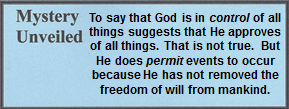
- Yet another interesting question remains: Where did the Essene community in West Jerusalem kill their Passover lambs if not in the temple? To complicate the potential answer, the Essenes believed the Sadducean establishment would corrupt their sacrificial lambs. Some scholars believe they may have sacrificed their lambs somewhere off the temple grounds, but that raises even more questions.
Any attempt at clarification is complicated by the fact that there was a variation between Galilean and Judean Passover observances. John’s gospel implies that the Last Supper was held the evening prior to the Passover feast while the synoptic gospels indicate that it was celebrated at the same time as the traditional Passover.[14] Furthermore, John states (19:14) that Jesus was condemned by Pilate on the “Day of Preparation of Passover.” If Jesus had celebrated Passover earlier, there clearly would not have been a conflict here, as the “Day of Preparation” would have been the time most other Jews were getting ready to sacrifice their lambs, and Jesus was going to be the sacrificed Lamb of God.[15]
According to Jewish tradition, some weeks had two Sabbaths, with the first of the two being known as the “Day of Preparation.” Some scholars believe this would have made it impossible for Jesus to be crucified on Good Friday, which was the day of Passover, therefore, there had to be some variation of calendar dates.[16] Other scholars have stated that Jews living in Dispersion observed Passover on Friday while those in Jerusalem observed it on Saturday.[17] What is known is that the Last Supper was a monumental event, and while some of its historical details are confusing or unknown, the plan of God is most certainly known. All gospels agree that Jesus died on Friday, the fourteenth day of Nissan.
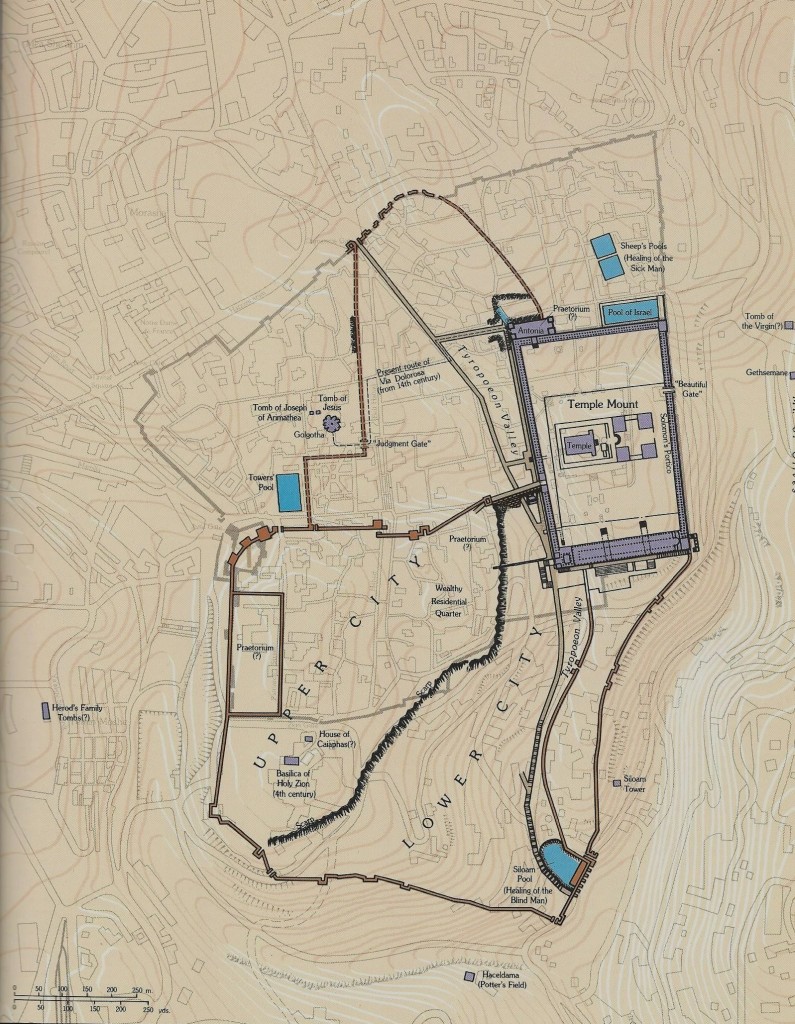
14.02.03.Z. Map of Jerusalem as it was at the Time of Jesus. The Essene quarter of Jerusalem was extremely close to the home of Caiaphas and where the disciples met for the Last Supper. Map courtesy of Dan Bahat.[18]
14.02.03.Q2 How authentic is the site of the Upper Room?
This is an interesting topic because scholars are rather certain that the location of the Upper Room, a/k/a The Cenaculum, has been authenticated although the structure was destroyed centuries ago.[19] A listing of significant events, as recorded by ancient witnesses, is placed in chronological order below. Sub-titles are given for clarity. But even among reliable sources there are at times conflicts: some reports indicate that all of Jerusalem was destroyed in the First Revolt of A.D. 70, while other writings claim to be witnesses of the building that once was the site of the Last Passover.
Post-Ascension of Jesus
It has been suggested that the historical events that transpired where the Upper Room once stood are reflective of the relationship between the Christians of Jewish and Gentile background. Not only did Jesus meet His disciples there for their Passover/Last Supper, but they returned to this room after His ascension to pray until the promised Holy Spirit fell upon them on the Day of Pentecost and where Peter preached his famous sermon of Acts 2.
Scholars consider two possible sites as to where the building once stood.
- The home of John Mark (minority view)
- A home on Mount Zion in the western part of Jerusalem (majority view)
This writer agrees with the overwhelming majority view, although some good friends believe otherwise. Visitors to Mount Zion today are informed that it was also the tomb of King David.[20] Some scholars believe that due to the loss of temple records (A.D. 70) and the deaths of key sages (A.D. 135), the precise location of the tomb is unknown.[21] Yet shortly after the crucifixion Peter said this concerning the tomb of David:
29 “Brothers, I can confidently speak to you about the patriarch David: He is both dead and buried, and his tomb is with us to this day.
Acts 2:29
However, Peter said “His tomb is with us to this day,” that statement does not necessarily identify location. Obviously, the apostle knew precisely where the tomb was, because it was adjacent to the site of the Last Supper and the Pentecost event.[22] After Pentecost, the Upper Room became the center of the Judeo-Christian synagogue in Jerusalem.[23] Scholars frequently refer to the first century congregation as a “church,” when, in fact, everyone who attended was Jewish and their worship service was a slightly modified version of the traditional synagogue service. They did not lose their Jewish culture or traditions because they became followers of Yeshua (Jesus).[24] This can be seen in Acts 1:12-13 when the Jewish believers honored the tradition of a “Sabbath’s Day walk” and went to the Upper Room.
Peter’s comment reflects the facts of biblical history, as well as the evil works of Herod the Great. At one time Herod attempted to rob the treasures from the tomb of King David. According to Josephus, he sent several grave robbers who successfully removed some of its wealth. Upon their return to the tomb, two of the men met sudden death by a flame of fire. The horrific news quickly spread throughout the city and frightened Herod so much that he immediately constructed a monument to honor the deceased King.[25] When Peter referred to King David, he most certainly was thinking of this event and the monument built by Herod.
The first churches, or messianic synagogues, were gatherings in homes and assembly halls. They carried the same Greek name synagogue meaning assembly, that in Hebrew is knesset.[26] In later years, Gentile Christians used the word ekklesia, or ecclesia, which also means assembly, for their place of gathering. Every home was called a domus ekklesia, or church house.[27] However, some scholars argue that the English word church was not accurately derived from ekklesia, but from the Greek kyriake meaning belonging to the Lord.[28] Early Jewish believers did not see themselves as a separate religious movement, but as a part of Judaism. Since the Jewish religion was a legal religion recognized by Rome, the Jewish believers were seen as being within Judaism and they did not always receive the persecution that Gentile believers received.
However, there is today a growing opinion that some synagogues did become messianic congregations – fellowships that followed a worship format similar to traditional synagogues but with the focus of Yeshua (Jesus). Just because Acts 2:46 says the believers “broke bread from house to house,” that does not mean they didn’t meet also as congregations. With such an explosion of believers it is most difficult to think that some synagogues did not change. While there is no existing written evidence of a first century messianic synagogue, scholars debate the archaeological evidence uncovered in Magdala to support the possibility of a first century messianic synagogue at that site (see 08.05.07.D).[29]
In the meantime, the Romans always had considerable difficulty understanding Judaism, so Christianity was beyond their comprehension. They could understand a god becoming human because they had similar stories of such in their mythologies. But to have a God become a man, suffer, be crucified, and rise from the dead was beyond their imagination! They could not understand why anyone would want to worship that kind of God.
A.D. 66-70 First Revolt
There is no question that the destruction of Jerusalem at Passover during A.D. 70, precisely forty years after the crucifixion of Jesus, was a judgment from the Divine. For more than fifteen centuries, from the time of Moses until Titus, no enemy ever attacked the Jewish people during the celebration of their festivals. The defeat and destruction was understood by Gentile Christians as punishment of the Jewish leaders. The city and temple had been built like a super-fortress by Herod the Great, a paranoid monarch, because he constantly feared Queen Cleopatra and the Egyptians to the south as well as the growing Parthian Empire to the East. The huge stones and massive walls were a profound challenge for the ancient Roman war machines. Amazingly, Titus recognized this and actually gave credit to God for his victory for the ability to destroy the fortified city.[30] His profound statement was preserved.
“We have certainly had God for our assistant in this war, and it was none other than God who ejected the Jews out of these fortifications; for what could the hands of men, or any machines do towards overthrowing these towers!”
Titus, quoted by Josephus, Wars 6.9.1 (411)
After the Romans left the city in ruins, the Jews rebuilt it. But they still had a passion for a messianic deliverer which, unfortunately, led to another destruction.
A.D. 132-135 Second Revolt[31]
The celebrated Rabbi Akiva (Akiba)[32] gave a messianic pretender, Simon bar Kokhba, the name “Son of the Star” and announced to the Jewish world that he was the long awaited messiah. Bar Kokhba then led a rebellion against the Romans in A.D. 132, but the Romans defeated him and his army, destroyed Jerusalem, and renamed the land Palestinia – a curse word from where the modern name “Palestine” is derived.[33]
By this time, the Romans were so exasperated with the Jews that Hadrian evicted all of them, traditional Jews and “Nazarenes” by imperial decree. Bar Kokhba was killed and the Rabbi Akiva’s body was literally butchered and his flesh sold in the Jerusalem market. Hadrian also attempted to eradicate all signs and significant sites (i.e. the crucifixion site) that pertained to the new Jewish sect known as Christianity. Today scholars debate whether the Church of the Apostles survived Hadrian’s destruction.[34] What is known is that so many the Jewish church leaders were killed that the leadership went into the hands of Gentile believers. With new Gentile leadership in the church, Jewish roots, idioms, and customs were soon forgotten. Furthermore, the Gentile leaders believed God permanently destroyed the Jewish state in His eschatological plan and all promises given to Abraham were transferred to the church. This idea became known as “replacement theology,”[35] and by the year 324, Church-sponsored anti-Semitism was firmly established. This horrific doctrine formulated how the church would treat Jews for centuries to come – and the treatment was utterly shameful.[36]
110-180 Hegesippus (A.D. 110-180)
Evidently the Upper Room had a lasting legacy. The historian Hegesippus[37] said that prior to the eviction of all Jews from Jerusalem by Emperor Hadrian there had been 15 Hebrew Christian bishops in the Holy City.[38] The fellowship that met previously in the Upper Room synagogue became known as the Church of the Apostles,[39] although others believe the Upper Room became known as the Holy Zion Church (Latin: Coenaculum). Franciscan father Bagatti and Bargil Pixner were among the scholars who examined the possible Church of the Apostles site and concluded that the structure was indeed a church because the niche in the north wall did not face north, nor the temple, but faced toward the crucifixion site.[40]
155-235 Cassius Dio Cocceianus (A.D. 155-235)
According to the Roman historian Cassius Dio Cocceianus, the monument built by Herod the Great that honored the tomb of King David survived the destruction of Titus, but collapsed during to the Second Jewish Revolt (A.D. 132-135).[41]
Late 3rd Century Eusebius of Caesarea (A.D. 265-340)
The famous early church father Eusebius of Caesarea wrote in his Demenstratio Evangelica that the western hill was known as Mount Zion from which the gospel went throughout the world. Undoubtedly, the Upper Room was where the Jerusalem Council met two decades later (Acts 15:1-29; Gal. 2:10). Today the Dominion Abbey of the Greek Orthodox Seminary is upon the Mount Zion as well as the alleged Tomb of David. Eusebius said,
This is the word of the gospel, which through our Lord Jesus Christ and through the apostles went out from Mount Zion and was spread to every nation. It is a fact that it poured forth from Jerusalem and Mount Zion adjacent to it, on which our Savior and Lord had stayed many times and where he taught much doctrine.
Eusebius, Demonstrations of the Gospel 265-340[42]
330 Epiphanius (310-403)
Around the year 330, Sanctus Epiphanius Constantiensis, commonly known as Epiphanius,[43] traveled to Jerusalem. He wrote of a small church building in western Jerusalem that survived Hadrian’s destruction of Jerusalem as follows,
Hadrian found the city completely leveled to the ground and God’s temple treaded down, except for a few houses and the church of God, which was quite small. To it the disciples returned after the Savior’s ascension from the Mount of Olives. They went up to the Upper Room, for it had been built there – that is, in the part of the city called Zion, which part was exempted from destruction, as also were some of the dwellings around Zion and seven synagogues, the only ones which existed in Zion, like monks’ cells. One of these survived until the time of Bishop Maximus and King Constantine. It was like a tent in a vineyard, to quote the Scripture.
Epiphanius, De Mensurie et Ponderibus 14[44]
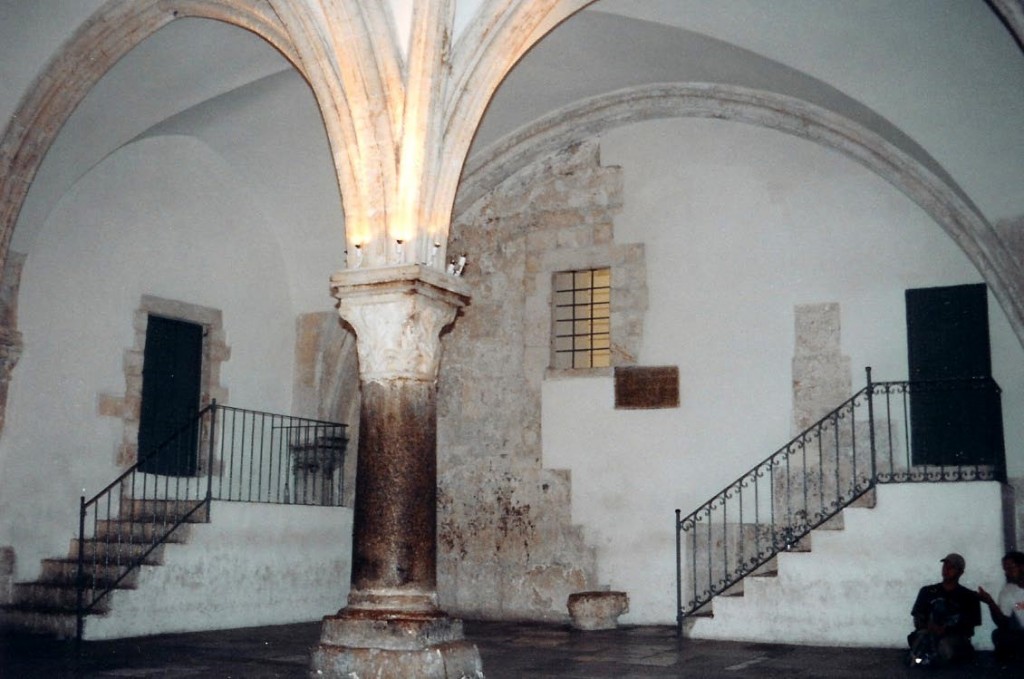
14.02.03.C. THE TRADITIONAL UPPER ROOM. The Upper Room seen by visitors today was rebuilt in European Gothic style by the Crusaders. The original one was destroyed by Hadrian’s Roman army in A.D. 135. Tradition says this is where Jesus met with His disciples for the Last Supper and where the Holy Spirit came upon the 120 believers on the Day of Pentecost. Photograph by the author.
Video Insert >
14.02.03.V The Upper Room as an Early Church. Dr. Petra Heldt discusses the location of the Upper Room and its possible use as an early church.
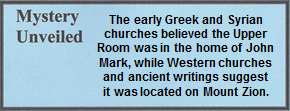
348 Saint Cyril (ca. 313-386)
The status and location of the Upper Room Church continues to be a matter of discussion for scholars. For example, Saint Cyril who, in the year 348, wrote that on the Feast of Pentecost the Holy Spirit descended from heaven “in the Upper Church of the Apostles” in Jerusalem.[45] Yet the question lingers as to whether the building survived the destructions of the city. Note the words of the first century historian,
And now the Romans set fire to the extreme parts of the city and burnt them down and entirely demolished the walls.
Josephus, Wars 6.9.4 (434b)
However, this phrase may have been literary license to illustrate how massive the destruction was. Scholars know, for example, that not all the perimeter walls of the city were destroyed. The three towers that were built by Herod the Great and a portion of the western city wall were also excluded from the destruction.
Caesar gave orders that they should now demolish the entire city and temple but should leave as many of the towers standing as were of the greatest eminency; that is Phasaelus, and Hippicus, and Mariamne, and so much of the wall as enclosed the city on the west side …. This was the end which Jerusalem came to by the madness of those that were for innovations; a city otherwise of great magnificence and of mighty fame among all mankind.
Josephus, Wars 7.1.1 (1)
6th Century Madaba Map
However, a major argument for the Mount Zion location is the 6th century Madaba Map that features the Upper Room.[46] This room was supposedly destroyed in the First Revolt and rebuilt facing the Church of the Holy Sepulchre, which suggests that the builders were Christian.[47] However, scholars debate this orientation and who the builders may have been after the First Revolt.[48] Clearly, the consensus of ancient writers is that the site of the Upper Room was in the western section of Jerusalem – an area also known from other sources to have been occupied by many Essene Jews.
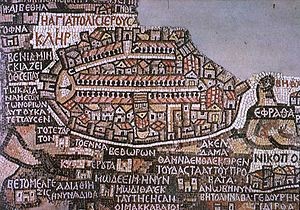
14.02.03.D. Jerusalem as depicted on the A.D. 542 mosaic Madaba Map. Wikipedia Commons.
[1]. Nelesen, Yeshua; the Promise, the Land, the Messiah. (Video Tape 2).
[2]. They could not have used grape juice because there are no grapes ripening in the spring of the year.
[3]. See Appendix 5.
[4]. 2 Kgs. 11:5; 1 Chron. 9:25; 24:19; Josephus, Antiquities 7.14.7; See also Simmons, “The Origin of Christmas and the Date of Christ’s Birth.” 321-22.
[5]. See also 1 Cor. 11:17-34.
[6]. Avi-Yonah and Kraeling, Our Living Bible. 288.
[7]. Josephus, Wars 5.9.4 (410).
[8]. Toynbee, The Crucible. 221.
[9]. Lk. 2:7; 22:11; Mk. 14:14.
[10]. See 04.03.10. For more information on a typical upper room, see video 04.07.01.V2; Cosby, Interpreting Biblical Literature. 10, 14.
[11]. Fruchtenbaum, The Jewish Foundation of the Life of Messiah: Instructor’s Manual. Class 22, page 5.
[12]. See 02.02.06.
[13]. Nelesen, Yeshua; the Promise, the Land, the Messiah. (Video Tape 2).
[14]. Mt. 26:17; Mk. 14:12; Lk. 22:7; For an excellent study on the various interpretations of this subject, see Joachim Jeremias, The Eucharistic Words of Jesus. London: SCM, 1966, 15-88.
[15]. See Appendix 6 concerning Old Testament sacrifices and Jesus; Appendix 9 outlines the New Testament plan of salvation as presented in the Old Testament.
[16]. Tenney, New Testament Times. 174.
[17]. Shepherd, “Are Both the Synoptics and John Correct About the Date of Jesus’ Death?” 123-132.
[18]. Bahat. Illustrated Atlas of Jerusalem. 55.
[19]. Notley, In the Master’s Steps. 66.
[20]. Since the Romans destroyed the temple in A.D. 70, the Jews wanted to honor their ancient King David who was born in Bethlehem. So they honored him in Bethlehem because they referred to the village as the “City of David.” Consequently, for centuries it was believed that David and Solomon were buried in the little hamlet town south of Jerusalem. Several ancient writers made reference to this historical error as fact. However, the truth is that King David was buried within the city of Jerusalem according to 1 Kings 2:10.
[21]. Schmalz, 20-21.
[22]. Schmalz, 21-22.
[23]. For more information on a typical upper room, see video 04.07.01.V2.
[24]. Mills and Michael, Messiah and His Hebrew Alphabet. 7.
[25]. Josephus, Antiquities 16.7.1; 7.15.3. (Don’t you just love an attitude adjustment from God?)
[26]. The same word as modern Israel’s legislative body.
[27]. Deissmann, Light from the Ancient East. 103, 112.
[28]. Pixner, “Church of the Apostles Found.” 24.
[29]. Pixner, “Church of the Apostles Found.” 24-26; See also “First Century Synagogue Found.” Israel Today E-Newsletter. January 15, 2013; Skarsaune. In the Shadow of the Temple. 183-88.
[30]. Titus was not about to miss any gods for his victory. He also traveled north to Caesarea Philippi and offered sacrifices to the god Pan in thankful celebration.
[31]. A/k/a Simon bar Kokhba Revolt.
[32]. After the destruction of the temple, Rabbi Akiva ( A.D. 50-135) was the founder of a great learning center in Jaffa and today is considered to be the father of rabbinic Judaism. He was killed by the Romans for supporting the messianic figure Simon bak Kokhba.
[33]. For further study, see Eusebius, Ecclesiastical History. 4:6; Dio Cassius, Roman History. 69:12-14.
[34]. Skarsuane reports that For archaeological research that suggests that he Skarsaune. In the Shadow of the Temple. .
[35]. See “Replacement Theology” in Appendix 26.
[36]. See William Heinrich, In the Shame of Jesus: The History of Church-Sponsored Anti-Semitism.
[37]. Saint Hegesippus was an early church theologian and historian who wrote against the heresies of the Gnostics and Marcion.
[38]. Moseley, Yeshua: A Guide to the Real Jesus and the Original Church. 7.
[39]. Pixner, “Church of the Apostles Found.” 24-26.
[40]. Skarsaune. In the Shadow of the Temple. 183-88; Pixner, “Church of the Apostles Found.” 24-26.
[41]. Dio Caccius, Roman History 69:14. http://orion.it.luc.edu/~avande1/jerusalem/sources/cassiusDio-69.htm Retrieved November 25, 2012. Cassius Dio Cocceianus (Dio Caccius), in A.D. 222, described how destructive Emperor Hadrian was toward the Jewish people. The historian said 580,000 men were killed, 985 villages destroyed, and the number who died from famine and disease could not be counted.
[42]. Eusebius quoted by Schmalz 22; Eusebius, Demonstratio Evangelica 1.4 ; Baldi, Enchiridion Locorum Sanctorum. 728, 474.
[43]. Epiphanius was a monk in Egypt and Palestine and eventually became the Bishop of Salamis, Cyprus. He was known for being a strong defender of orthodoxy.
[44]. Mackowski, Jerusalem City of Jesus. 143; Baldi, Enchiridion Locorum Sanctorum. 733, 478.
[45]. Baldi, Enchiridion Locorum Sanctorum. 730, 475.
[46]. The mosaic Madaba Map is in the village of Madaba, located about 20 miles south of Amman, the capital of Jordan. It measures approximately 51 feet (north to south) by 19 feet (east to west) totally about 969 square feet that contained about 1.1 million tesserae, which are the small colored mosaic tiles.
[47]. See “Madaba Map” in Appendix 26; See also 14.02.03.D and 05.02.03.Z. There is a common opinion that synagogues were built facing the temple. However, archaeological surveys on many of the 200 synagogue ruins reveal that pre-destruction synagogues did not face the temple. Only after the temple was destroyed, were synagogues built facing the Holy City. For further study, see Hachlili, Rachel. “Synagogues: Before and After the Roman Destruction of the Temple.” Biblical Archaeology Review. 41:3 (May/June 2015) 30-38, 65.
[48]. Zondervan New International Version Archaeological Study Bible. (2005 ed.) 1654.